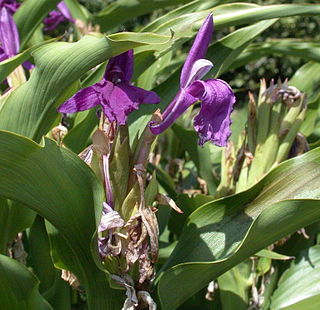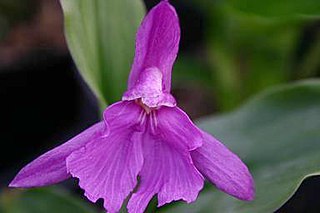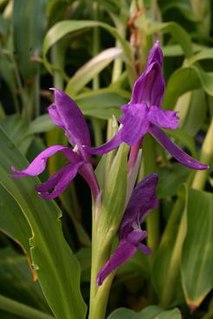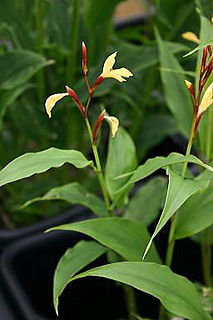
Roscoea is a genus of perennial plants of the family Zingiberaceae. Most members of the family are tropical, whereas Roscoea species are native to mountainous regions of the Himalayas, China and its southern neighbours. Roscoea flowers superficially resemble orchids, although they are not related. The flowers of Roscoea have a complicated structure, in which some of the showy coloured parts are not formed by petals, but by staminodes, sterile stamens which have evolved to become like petals. Some species are grown as ornamental plants in gardens.

Roscoea auriculata is a perennial herbaceous plant occurring in the eastern Himalayas, in Tibet, Bhutan, Nepal and Sikkim. Most members of the ginger family (Zingiberaceae), to which it belongs, are tropical, but R. auriculata, like other species of Roscoea, grows in much colder mountainous regions. It is sometimes grown as an ornamental plant in gardens.

Roscoea cautleyoides is a perennial herbaceous plant occurring in the Sichuan and Yunnan provinces of China. The scientific name is also spelt Roscoea cautleoides. Most members of the ginger family (Zingiberaceae), to which it belongs, are tropical, but R. cautleyoides, like other species of Roscoea, grows in much colder mountainous regions. It is sometimes grown as an ornamental plant in gardens.

Roscoea purpurea is a perennial herbaceous plant occurring in the Himalayas, particularly Nepal. Most members of the ginger family (Zingiberaceae), to which it belongs, are tropical, but species of Roscoea grow in much colder mountainous regions. It is sometimes grown as an ornamental plant in gardens.

Roscoea alpina is a perennial herbaceous plant native to the Himalayas. Most members of the ginger family (Zingiberaceae), to which it belongs, are tropical, but R. alpina, like other species of Roscoea, grows in much colder mountainous regions. It is sometimes grown as an ornamental plant in gardens.

Roscoea tibetica is a perennial herbaceous plant native to the mountains of China, being found in Tibet, Sichuan and Yunnan. The species formerly included plants found in Bhutan; in 2000, these were separated into a new species, Roscoea bhutanica. Most members of the ginger family (Zingiberaceae), to which it belongs, are tropical, but R. tibetica, like other species of Roscoea, grows in much colder mountainous regions. R. tibetica is sometimes grown as an ornamental plant in gardens. In 2020, it was proposed that R. tibetica be split again.

Roscoea kunmingensis is a perennial herbaceous plant native to the mountains of China, being found in Yunnan. Most members of the ginger family (Zingiberaceae), to which it belongs, are tropical, but R. kunmingensis, like other species of Roscoea, grows in much colder mountainous regions.

Roscoea capitata is a perennial herbaceous plant native to the Himalayas, being found in Nepal. Most members of the ginger family (Zingiberaceae), to which it belongs, are tropical, but R. capitata, like other species of Roscoea, grows in much colder mountainous regions.

Roscoea forrestii is a perennial herbaceous plant occurring in the Sichuan and Yunnan provinces of China. Most members of the ginger family (Zingiberaceae), to which it belongs, are tropical, but R. forrestii, like other species of Roscoea, grows in much colder mountainous regions. It is sometimes grown as an ornamental plant in gardens. It was named after George Forrest (1873-1932) who discovered it in Yunnan.

Roscoea tumjensis is a perennial herbaceous plant occurring in the Himalayas, in Nepal. Most members of the ginger family (Zingiberaceae), to which it belongs, are tropical, but R. tumjensis, like other species of Roscoea, grows in much colder mountainous regions.
Roscoea cangshanensis is a perennial herbaceous plant native to the mountains of China, being found in Yunnan. Most members of the ginger family (Zingiberaceae), to which it belongs, are tropical, but R. canshanensis, like other species of Roscoea, grows in much colder mountainous regions.

Roscoea praecox is a perennial herbaceous plant occurring in the Yunnan province of China. Most members of the ginger family (Zingiberaceae), to which it belongs, are tropical, but R. praecox, like other species of Roscoea, grows in much colder mountainous regions. It is sometimes grown as an ornamental plant in gardens.

Roscoea debilis is a perennial herbaceous plant found in Yunnan, China. Most members of the ginger family (Zingiberaceae), to which it belongs, are tropical, but R. debilis, like other species of Roscoea, grows in much colder mountainous regions.
Roscoea ngainoi is a perennial herbaceous plant occurring in the Ukhrul district of Manipur state, India. Most members of the ginger family (Zingiberaceae), to which it belongs, are tropical, but like other species of Roscoea, R. ngainoi grows in much colder mountainous regions.
Roscoea ganeshensis is a perennial herbaceous plant occurring in Ganesh Himal in central Nepal. Most members of the ginger family (Zingiberaceae), to which it belongs, are tropical, but like other species of Roscoea, R. ganeshensis grows in much colder mountainous regions. It is used as an ornamental garden plant, requiring moisture and shade in the summer.

Roscoea × beesiana is considered to be a hybrid between R. auriculata and R. cautleyoides which occurred in cultivation. The flowers are variable: most forms have a pale cream base colour with varying amounts of purple streaking, particularly on the lip or labellum. It was given the Award of Garden Merit by the Royal Horticultural Society in 2011. It is classified as being hardy throughout the British Isles.

Roscoea wardii is a perennial herbaceous plant occurring from eastern Arunachal Pradesh in India to western Yunnan in China. Most members of the ginger family (Zingiberaceae), to which it belongs, are tropical, but like other species of Roscoea, R. wardii grows in much colder mountainous regions.

Roscoea scillifolia is a perennial herbaceous plant occurring in Yunnan in China. Most members of the ginger family (Zingiberaceae), to which it belongs, are tropical, but like other species of Roscoea, R. scillifolia grows in much colder mountainous regions. As of 2013, the species is only known in cultivation and may be extinct in the wild.

Cautleya gracilis is a perennial herbaceous plant in the family Zingiberaceae. It is found in the Himalayas through to south China and Vietnam. It is cultivated as an ornamental garden plant, hardy to a few degrees of frost.

Cautleya spicata is a perennial herbaceous plant in the family Zingiberaceae. It is found in the Himalayas through to China (Yunnan). It is cultivated as an ornamental garden plant, hardy to a few degrees of frost.
















